Michael J. Kramer's Blog, page 14
July 28, 2023
July 17, 2023
Adult Content
 W. H. Auden, Fire Island, 1946
W. H. Auden, Fire Island, 1946To grow up does not mean to outgrow either childhood or adolescence but to make use of them in an adult way. But for the child in us, we should be incapable of intellectual curiosity.
— W.H. Auden, h/t Nick Laird, “Auden’s Dialectic,” New York Review of Books, 68
July 12, 2023
Woodstock Muzak Festival
 Wide-angle overall of huge crowd facing the distant stage, during the Woodstock Music & Art Fair. Photo: John Dominis/The LIFE Picture Collection via Getty Images.
Wide-angle overall of huge crowd facing the distant stage, during the Woodstock Music & Art Fair. Photo: John Dominis/The LIFE Picture Collection via Getty Images.It wasn’t a rebellion, or even rebellious, but rather the citizens of a city doing as they pleased—taking off their clothes, staying up all night—for the pleasure of it. It was a raised finger to no one. Dreams of revolution were replaced by ordinary realities of freedom…. It was 450,000 people trapped in an elevator, making the best of it, and, in some weirdly mythic way, not forgetting, once the elevator came unstuck, to keep in touch. It was a magnificent accident.
— Greil Marcus, “Days Between Stations” column, Interview Magazine, July 1994
July 9, 2023
Trapped In the Middle
 Phoebe Waller-Bridge. Photo: Mamadi Doumbouya.
Phoebe Waller-Bridge. Photo: Mamadi Doumbouya.We’re not in a period like the 80s when we were like: ‘Go! Go! Money and future and tech!’ It’s not a supernostalgic time either. We’re somewhere trapped in the middle. So what does it mean to be part of this era? It’s like that old nursery rhyme: You can’t go over it, you can’t go under it, you’ve got to go through it.
June 30, 2023
Rovings
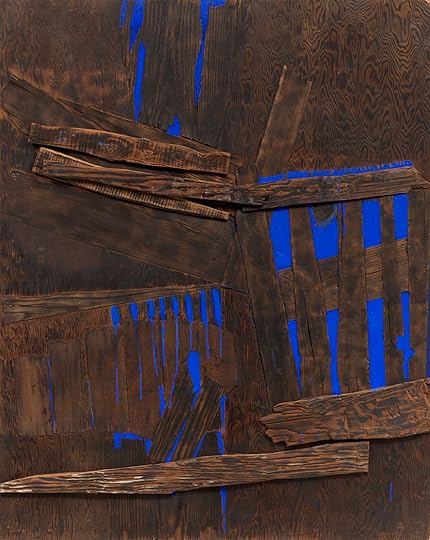 Benjamin Wigfall, Untitled, ca. 1957-70.SoundsJoao Gilberto, “Eu vim de Bahia”Gilberto Gil, “Eu vim de Bahia”Tina Turner, Tina Turns the Country On!Odetta, Odetta SingsJoe Hickerson, Drive Dull Care Away, Vols. 1 and 2Ave Sangria, Ave SangriaVarious Performers in the Sikasso region, Meenyirigi, Music of the Senufo and Minianka in MaliVarious Artists, Côte d’Ivoire: A Senufo-Fodonon — Funerary Vigil (UNESCO Collection from Smithsonian Folkways)Various Artists, Soul of Angola: Anthologie de la Musique Angolaise 1965-1975The Brute Force Stringband, Beauty and the Brute ForceThe Brute Force Stringband, Music to Awaken the Ballroom Beast“Sunday Feature: Government Song Woman,” BBC SoundsPamela Z, Wire MixLucretia Dalt, Ay!Steven Ricks & Ron Coulter, PrecipitationsEiko Ishibashi, The Dream My Bones DreamBob Dylan, Shadow KingdomHenry Threadgill, The Other OneFive-Part Series on Tony Schwartz, BBC 4Kitchen Sisters, Tony Schwartz: 30,000 Recordings LaterMarta Salogni, Music for Open SpacesErland Cooper, LandformWGXC Afternoon Show: Jillian McDonald, 10 June 2023“History is Over,” Throughline, 2021, rebroadcast 18 May 2023David Grisman, New Smokey Grass Boys“Moses Asch: Recording the World,” Smithsonian Sidedoor Podcast, 7 June 2023Various Artists, Lost Train Blues: John & Alan Lomax and the Early Folk Music Collections at the Library of CongressWordsLaura Phipps, “My Roots Extend”: Jaune Quick-to-See Smith and the Landscape of Memory, Whitney Museum of Art Blog, 19 April 2023Various Authors, “From the Global to the Planetary”, H-Diplo|RJISSF Roundtable Discussion, 1 June 2023Nilay Patel, “AI Drake just set an impossible legal trap for Google,” The Verge, 19 April 2023 Amanda Hoover, “Spotify Has an AI Music Problem—but Bots Love It,” Wired, 11 May 2023 Lawrence Kumpf and Magnus Nygren, “The Revolution Is Inside: On Don and Moki Cherry’s Collaborations,” Blank Forms 06: Organic Music SocietiesStellan Vinthagen, “How subaltern studies changed our understanding of resistance struggles,” Resistance Studies, 1 May 2023John Adamian, “A Bag of Old Songs from Elsewhere,” JSTOR Daily, 7 September 2016Grace Elizabeth Hale, “Documentary Noise,” Southern Cultures 23, 1 (Spring 2017), 10-32Emily Widerholt and Soo Jung Bae, “The Relationship between Rights and Dance: An Interview with Wonyoung Kim,” Stance on Dance, 12 June 2023Ann Manov, “A Considerable Aura: On Adam Shatz’s ‘Writers and Missionaries,'” LARB, 6 June 2023Tim Riley, “How Much Faith Is Left?: On Warren Zanes’s “Deliver Me from Nowhere,” LARB, 9 June 2023George Scialabba, “Alasdair MacIntyre and Richard Rorty’s lifelong argument,” The Nation, 2 May 2023Matthew Gandy, “Books Under Threat: Open Access Publishing and the Neo-Liberal Academy,” Area, 7 May 2023Nathan J. Robinson and Alissa Quart, “We Must Banish ‘Bootstraps’ Mythology From American Life,” Current Affairs, 14 June 2023Niklas Plaetzer, “The Volcano of Imagination: A Cornelius Castoriadis Forum,” JHI Blog, 14 June 2023Mary Anne Trasciatti, “Cancelling Elizabeth Gurley Flynn,” Labor Online, 24 May 2023David Suisman and Susan Strasser, eds., Sound in the Age of Mechanical ReproductionSam Lebovic, “Here, There and Everywhere”: The Beatles, America, and Cultural Globalization, 1964—1968, Journal of American Studies 51, 1 (February 2017), pp. 43-65Erica Hellerstein, “The Politics of Teaching US History,” Coda, 13 June 2023Lee Harris, “Is Capitalism Really Cracking Up Nation-States?,” American Prospect, 7 June 2023Jeffrey Herlihy-Mera, “Where the Humanities Are Not in Crisis,” LARB, 16 June 2023Marcus Rediker, “In his time, Benjamin Lay may have been the most radical person on the planet: Benjamin Lay was one of the first practical abolitionists, grounded in the real day-to-day struggles of enslaved peoples of African descent,” Verso Books Blog, 2 May 2023Monica Westin, “Ingenious librarians: A group of 1970s campus librarians foresaw our world of distributed knowledge and research, and designed search tools for it,” Aeon, 5 June 2023Richard L. Hasen and Dahlia Lithwick, “There’s Unsettling New Evidence About William Rehnquist’s Views on Segregation,” Slate, 1 June 2023David A. Bell, “Ego-Histories,” New York Review of Books, 22 June 2023 Marc Weidenbaum. “The Sonic Triumph of American Graffiti,” JSTOR Daily, 17 May 2023Brian Callaci, “When Socialists Put an End to Pasta Inflation,” Jacobin, 11 June 2023Theo Williams, “George Padmore Played a Vital Role in the Struggle Against Colonial Oppression,” Jacobin, 9 June 2023Bruce Jackson, ed., Folklore & Society: Essays in Honor of Benjamin A. BotkinM. Mitchell Waldrop, The Dream Machine: J.C.R. Licklider and the Revolution That Made Computing PersonalBhakti Shringarpure, Cold War Assemblages: Decolonization to DigitalGeorge W. Stocking, Race, Culture, and Evolution: Essays in the History of AnthropologyJohn Niven, Music from Big Pink: A NovellaRosemary Levy Zumwalt, American Folklore Scholarship: A Dialogue of Dissent“Walls”Shift: Music, Meaning, Context @ Museum of Contemporary PhotographyThis Is Britain: Photographs from the 1970s and 1980s @ National Gallery of ArtPhilip Guston Now @ National Gallery of ArtRobert Longo, Drawings: Engines of State @ National Gallery of ArtCalled to Create: Black Artists of the American South @ National Gallery of ArtJaune Quick-to-See Smith, Memory Map @ Whitney Museum of American ArtAmber Robles-Gordon, Remnants: A visual journey of memory and renewal @ IA&A at HillyarElaine Reichek, Frock-Conscious @ Shoshana Wayne GalleryDavid Ireland, The Condition Where Art Would Disappear @ 500 Capp StreetSarah Sze, Timelapse @ Guggenheim MuseumFrank Bowling, The New York Years: 1966-1975 @ SFMoMA Mark Bradford @ Hauser and WirthTerry Allen @ Amarillo Museum of ArtFlorian Krewer, everybody rise @ Aspen Museum of ArtBenjamin Wigfall and Communications Village @ VMFAJason Stopa, Garden of Music @ Diane Rosenstein GalleryTouching Roots: Black Ancestral Legacies in the Americas @ Museum of Fine Arts BostonAmy Brener, Harbingers @ Aldrich Contemporary Art MuseumPrima Materia: The Periodic Table in Contemporary Art @ Aldrich Contemporary Art MuseumChosen Memories: Contemporary Latin American Art from the Patricia Phelps de Cisneros Gift and Beyond @ MoMAWill Gabaldón, Phantom @ Galeria MascotaEsteban Cabeza de Baca, Alma @ Garth Greenan Gallery“Stages”Radio Golf @ Round House Theater, 20 June 2023Shirley Moody-Turner, “Anna Julia Cooper: An Interpretive Biography” @ Hutchins Center, 19 April 2023Fred Turner, “The Family of Man and the Politics of Attention in Cold War America” @ The Stanford Center on Democracy, Development and the Rule of Law, 13 February 2014Gavin Butt and Ben Highmore, “When the Leeds Art Experiment Went Punk” @ Popular Music Books in Progress Seminar, 20 February 2023Michael Sandel, Keynote @ The National Center for the Study of Collective Bargaining in Higher Education and the Professions Conference, 27 March 2023Michael Sandel, “The Tyranny of Merit: Can We Find the Common Good?” @ Geneva Graduate Institute, 27 September 2022Body Watani Dance Project; choreographed by Leila and Noelle Awadallah, TERRANEA: hakawatia of the sea @ Arab American National Museum, 28 April 2023Robert Irwin @ DIA Beacon, 18 May 2023Mutu X Music: Afrobeat, Hip Hop, Funk, and the Art of Wangechi Mutu @ New Museum, 16 June 2023Link Ray, “Rawhide” @ Saturday Night Beech-Nut Show, March 1959Sun Ra Arkastra @ Jazz Jamboree, Poland, 22 October 1987ScreensSummer of Rockets
Handsworth Songs
Nimrod Workman: To Fit My Own Category
Mary Carter and Gail Stoddard, “The Devils In The Phone Booth Dialing 911” Excerpt from The Power Of Audio With Tony Schwartz
Elijah Pierce: Wood Carver
Kea’s Arc
Benjamin Wigfall, Untitled, ca. 1957-70.SoundsJoao Gilberto, “Eu vim de Bahia”Gilberto Gil, “Eu vim de Bahia”Tina Turner, Tina Turns the Country On!Odetta, Odetta SingsJoe Hickerson, Drive Dull Care Away, Vols. 1 and 2Ave Sangria, Ave SangriaVarious Performers in the Sikasso region, Meenyirigi, Music of the Senufo and Minianka in MaliVarious Artists, Côte d’Ivoire: A Senufo-Fodonon — Funerary Vigil (UNESCO Collection from Smithsonian Folkways)Various Artists, Soul of Angola: Anthologie de la Musique Angolaise 1965-1975The Brute Force Stringband, Beauty and the Brute ForceThe Brute Force Stringband, Music to Awaken the Ballroom Beast“Sunday Feature: Government Song Woman,” BBC SoundsPamela Z, Wire MixLucretia Dalt, Ay!Steven Ricks & Ron Coulter, PrecipitationsEiko Ishibashi, The Dream My Bones DreamBob Dylan, Shadow KingdomHenry Threadgill, The Other OneFive-Part Series on Tony Schwartz, BBC 4Kitchen Sisters, Tony Schwartz: 30,000 Recordings LaterMarta Salogni, Music for Open SpacesErland Cooper, LandformWGXC Afternoon Show: Jillian McDonald, 10 June 2023“History is Over,” Throughline, 2021, rebroadcast 18 May 2023David Grisman, New Smokey Grass Boys“Moses Asch: Recording the World,” Smithsonian Sidedoor Podcast, 7 June 2023Various Artists, Lost Train Blues: John & Alan Lomax and the Early Folk Music Collections at the Library of CongressWordsLaura Phipps, “My Roots Extend”: Jaune Quick-to-See Smith and the Landscape of Memory, Whitney Museum of Art Blog, 19 April 2023Various Authors, “From the Global to the Planetary”, H-Diplo|RJISSF Roundtable Discussion, 1 June 2023Nilay Patel, “AI Drake just set an impossible legal trap for Google,” The Verge, 19 April 2023 Amanda Hoover, “Spotify Has an AI Music Problem—but Bots Love It,” Wired, 11 May 2023 Lawrence Kumpf and Magnus Nygren, “The Revolution Is Inside: On Don and Moki Cherry’s Collaborations,” Blank Forms 06: Organic Music SocietiesStellan Vinthagen, “How subaltern studies changed our understanding of resistance struggles,” Resistance Studies, 1 May 2023John Adamian, “A Bag of Old Songs from Elsewhere,” JSTOR Daily, 7 September 2016Grace Elizabeth Hale, “Documentary Noise,” Southern Cultures 23, 1 (Spring 2017), 10-32Emily Widerholt and Soo Jung Bae, “The Relationship between Rights and Dance: An Interview with Wonyoung Kim,” Stance on Dance, 12 June 2023Ann Manov, “A Considerable Aura: On Adam Shatz’s ‘Writers and Missionaries,'” LARB, 6 June 2023Tim Riley, “How Much Faith Is Left?: On Warren Zanes’s “Deliver Me from Nowhere,” LARB, 9 June 2023George Scialabba, “Alasdair MacIntyre and Richard Rorty’s lifelong argument,” The Nation, 2 May 2023Matthew Gandy, “Books Under Threat: Open Access Publishing and the Neo-Liberal Academy,” Area, 7 May 2023Nathan J. Robinson and Alissa Quart, “We Must Banish ‘Bootstraps’ Mythology From American Life,” Current Affairs, 14 June 2023Niklas Plaetzer, “The Volcano of Imagination: A Cornelius Castoriadis Forum,” JHI Blog, 14 June 2023Mary Anne Trasciatti, “Cancelling Elizabeth Gurley Flynn,” Labor Online, 24 May 2023David Suisman and Susan Strasser, eds., Sound in the Age of Mechanical ReproductionSam Lebovic, “Here, There and Everywhere”: The Beatles, America, and Cultural Globalization, 1964—1968, Journal of American Studies 51, 1 (February 2017), pp. 43-65Erica Hellerstein, “The Politics of Teaching US History,” Coda, 13 June 2023Lee Harris, “Is Capitalism Really Cracking Up Nation-States?,” American Prospect, 7 June 2023Jeffrey Herlihy-Mera, “Where the Humanities Are Not in Crisis,” LARB, 16 June 2023Marcus Rediker, “In his time, Benjamin Lay may have been the most radical person on the planet: Benjamin Lay was one of the first practical abolitionists, grounded in the real day-to-day struggles of enslaved peoples of African descent,” Verso Books Blog, 2 May 2023Monica Westin, “Ingenious librarians: A group of 1970s campus librarians foresaw our world of distributed knowledge and research, and designed search tools for it,” Aeon, 5 June 2023Richard L. Hasen and Dahlia Lithwick, “There’s Unsettling New Evidence About William Rehnquist’s Views on Segregation,” Slate, 1 June 2023David A. Bell, “Ego-Histories,” New York Review of Books, 22 June 2023 Marc Weidenbaum. “The Sonic Triumph of American Graffiti,” JSTOR Daily, 17 May 2023Brian Callaci, “When Socialists Put an End to Pasta Inflation,” Jacobin, 11 June 2023Theo Williams, “George Padmore Played a Vital Role in the Struggle Against Colonial Oppression,” Jacobin, 9 June 2023Bruce Jackson, ed., Folklore & Society: Essays in Honor of Benjamin A. BotkinM. Mitchell Waldrop, The Dream Machine: J.C.R. Licklider and the Revolution That Made Computing PersonalBhakti Shringarpure, Cold War Assemblages: Decolonization to DigitalGeorge W. Stocking, Race, Culture, and Evolution: Essays in the History of AnthropologyJohn Niven, Music from Big Pink: A NovellaRosemary Levy Zumwalt, American Folklore Scholarship: A Dialogue of Dissent“Walls”Shift: Music, Meaning, Context @ Museum of Contemporary PhotographyThis Is Britain: Photographs from the 1970s and 1980s @ National Gallery of ArtPhilip Guston Now @ National Gallery of ArtRobert Longo, Drawings: Engines of State @ National Gallery of ArtCalled to Create: Black Artists of the American South @ National Gallery of ArtJaune Quick-to-See Smith, Memory Map @ Whitney Museum of American ArtAmber Robles-Gordon, Remnants: A visual journey of memory and renewal @ IA&A at HillyarElaine Reichek, Frock-Conscious @ Shoshana Wayne GalleryDavid Ireland, The Condition Where Art Would Disappear @ 500 Capp StreetSarah Sze, Timelapse @ Guggenheim MuseumFrank Bowling, The New York Years: 1966-1975 @ SFMoMA Mark Bradford @ Hauser and WirthTerry Allen @ Amarillo Museum of ArtFlorian Krewer, everybody rise @ Aspen Museum of ArtBenjamin Wigfall and Communications Village @ VMFAJason Stopa, Garden of Music @ Diane Rosenstein GalleryTouching Roots: Black Ancestral Legacies in the Americas @ Museum of Fine Arts BostonAmy Brener, Harbingers @ Aldrich Contemporary Art MuseumPrima Materia: The Periodic Table in Contemporary Art @ Aldrich Contemporary Art MuseumChosen Memories: Contemporary Latin American Art from the Patricia Phelps de Cisneros Gift and Beyond @ MoMAWill Gabaldón, Phantom @ Galeria MascotaEsteban Cabeza de Baca, Alma @ Garth Greenan Gallery“Stages”Radio Golf @ Round House Theater, 20 June 2023Shirley Moody-Turner, “Anna Julia Cooper: An Interpretive Biography” @ Hutchins Center, 19 April 2023Fred Turner, “The Family of Man and the Politics of Attention in Cold War America” @ The Stanford Center on Democracy, Development and the Rule of Law, 13 February 2014Gavin Butt and Ben Highmore, “When the Leeds Art Experiment Went Punk” @ Popular Music Books in Progress Seminar, 20 February 2023Michael Sandel, Keynote @ The National Center for the Study of Collective Bargaining in Higher Education and the Professions Conference, 27 March 2023Michael Sandel, “The Tyranny of Merit: Can We Find the Common Good?” @ Geneva Graduate Institute, 27 September 2022Body Watani Dance Project; choreographed by Leila and Noelle Awadallah, TERRANEA: hakawatia of the sea @ Arab American National Museum, 28 April 2023Robert Irwin @ DIA Beacon, 18 May 2023Mutu X Music: Afrobeat, Hip Hop, Funk, and the Art of Wangechi Mutu @ New Museum, 16 June 2023Link Ray, “Rawhide” @ Saturday Night Beech-Nut Show, March 1959Sun Ra Arkastra @ Jazz Jamboree, Poland, 22 October 1987ScreensSummer of Rockets
Handsworth Songs
Nimrod Workman: To Fit My Own Category
Mary Carter and Gail Stoddard, “The Devils In The Phone Booth Dialing 911” Excerpt from The Power Of Audio With Tony Schwartz
Elijah Pierce: Wood Carver
Kea’s Arc
June 23, 2023
Hanging in the Balance
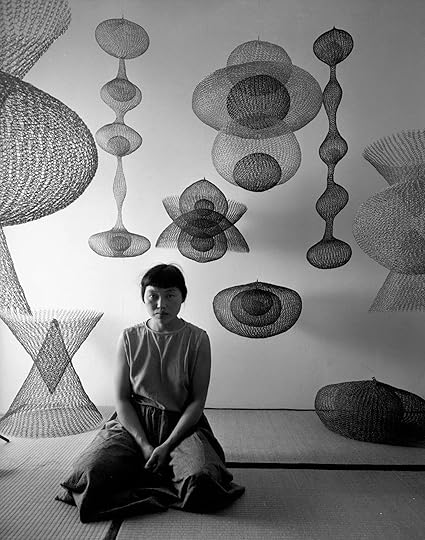 Ruth Asawa and artworks, 1954. Photo: Nat Farbman, Time & Life Pictures via Getty Images.
Ruth Asawa and artworks, 1954. Photo: Nat Farbman, Time & Life Pictures via Getty Images.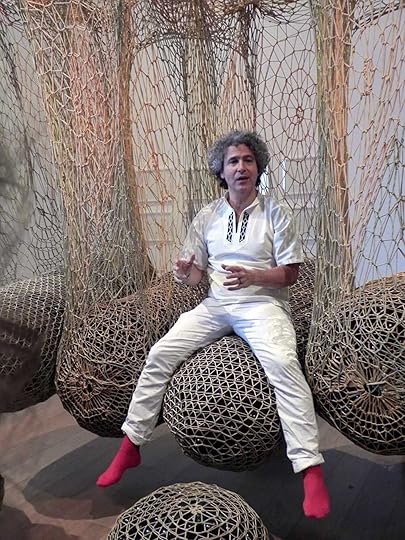 Ernesto Neto and one of his installations, 2015. Photo: María François.
Ernesto Neto and one of his installations, 2015. Photo: María François.Ruth Asawa and Ernesto Neto both use nets, weaves, cages, mesh, webbing. You’d think their work would be about enclosures, envelopments, maybe even traps and snares, but instead the pieces feel open and airy. The air passes through. Bodies pass through. Life passes through. There is breath, space, rest, an organic sense of comfort. OK, maybe there are hints of something more icky and sticky with Neto’s pieces, an edge of the gooey and maybe even the troubling. Overall, though, as with Asawa’s works, they are mostly playful and soothing.
In Asawa and Neto’s work, even when their creations are still, the shapes seem to drip, droop, drop. They swoop, sway, tickle. They tilt, lilt, and flicker. They are graceful. They smile, although they can be dead serious too. They dance. They don’t falter. Instead of capture or control, something else hangs in the balance with these sculptures: maybe the question of gravity itself, how it can hold us—and sometimes even let us float.
June 21, 2023
The Pie Plate Theory of History
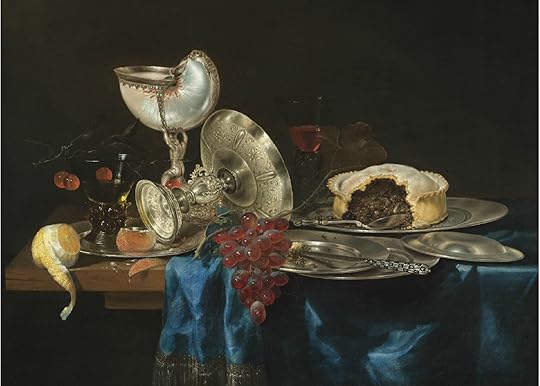 Gerrit Willemsz Heda, Still Life with a Nautilus Cup, a Meat Pie, a Bunch of Grapes, Some Pewter Plates and a Partly-Peeled Lemon, All Arranged on a Partly-Draped Table, 1646.
Gerrit Willemsz Heda, Still Life with a Nautilus Cup, a Meat Pie, a Bunch of Grapes, Some Pewter Plates and a Partly-Peeled Lemon, All Arranged on a Partly-Draped Table, 1646.…history can be viewed as a series of pie plates stacked somewhat irregularly one upon another. The irregularity is important, for the pie plates themselves have thickness in time—what we are in fact investigating as intellectual historians are ‘contexts of assumption’ which exist through time in complex interrelation with each other. At this point, visual representation breaks down, but the pie-plate metaphor perhaps does serve to emphasize the element of discontinuity in history, the importance of synchronic or horizontal contextual analysis, and the somewhat problematic character of diachronic relationships. Furthermore, the opacity of pie plates may help to remind us of the problems inherent in historical perception from the top of the pile.
— George W. Stocking, Jr., h/t Rosemary Lévy Zumwalt
Questions Make the Frame
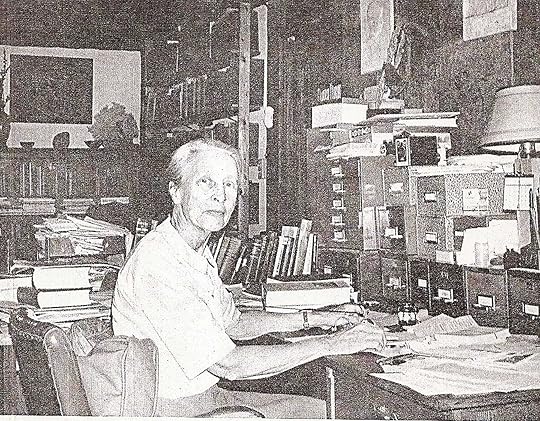
A philosophy is characterized more by the formulation of its problems than by its solution of them. Its answers establish an edifice of facts; but its questions make the frame in which its picture of facts is plotted. They make more than the frame; they give the angle of perspective, the palette, the style in which the picture is drawn—everything except the subject. In our questions lie our principles of analysis, and our answers may express whatever those principles are able to yield.
—Susanne Langer, Philosophy in a New Key






